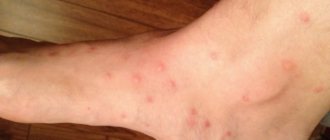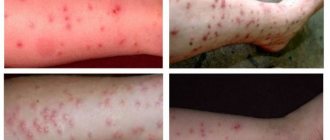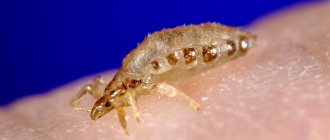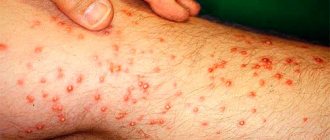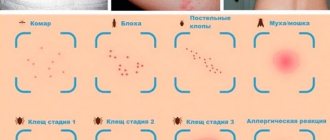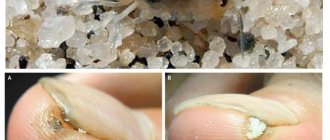What does a blood-sucking parasite look like: description and photo
The body length of a human flea reaches 3 mm. Insects can be recognized by the following characteristics:
- flattened body shape;
- black-brown or brown color of the body;
- numerous hairs and hooks covering the limbs and body of the parasite;
- lack of wings.
To distinguish a human flea from its relatives, you will need a magnifying glass or microscope.
Externally, the insect may look like a brown seed. The photos and pictures show close-ups of what fleas (moose, rat, etc.) and their larvae look like, as well as what bites look like on human skin on various parts of the body.
Features of fleas
About 90% of parasites live in the basements of residential buildings. From there they move into apartments.
Most often, residents of the lower floors are exposed to flea infestations. In addition, insects can disturb those who live close to the roof. This is explained by the fact that fleas love to live in nests that birds make in attics.
Pests can enter a person’s home in several ways:
- caught on the clothes and shoes of passers-by;
- independently moving from neighboring apartments, as well as from attics and basements;
- with pets.
The maximum life cycle of a flea is 500 days, but individuals usually live only a few months. During this time, the female manages to lay about 500 eggs.
Treatment options
If your feet itch unbearably, the first thing you should do is not scratch the bite sites, but resort to pharmaceutical or folk remedies. You can perform the procedures yourself only if there is no allergic reaction.
Special ointments and creams for treating bites
Special pharmaceutical preparations, which are produced in the form of ointments and creams, will help get rid of itching:
- “Fenistil-gel”. Helps relieve itching and irritation. The gel quickly penetrates the skin due to its light texture. Relieves swelling and pain, has a cooling effect.
- “Kalamine.” It comes in the form of a solution that needs to be applied to a cotton swab and spread on the places where there are bite marks. “Calamine” dries and soothes irritated areas of the epidermis.
- “Psilo-balm.” Able to cope with severe itching. Has calming and antiallergic properties.
- Hydrocortisone ointment. If you treat the skin immediately after a bite, the ointment helps stop the allergic reaction. Fights inflammation and relieves swelling.
- Balm “Rescuer”. It is recommended to smear the drug on the combed areas, as Rescuer has healing and disinfecting properties.
- Balm “Star”. Refers to inexpensive but effective means. Easily copes with unpleasant sensations after insect bites.
Special ointments for treating bites.
Folk remedies
If you don’t have pharmaceutical ointments at hand, then traditional methods will help:
- Healing herbs. A tincture of dried chamomile flowers, string leaves, calendula, lavender, and parsley root will help relieve swelling, redness and itching. 2 tbsp. Pour a glass of boiling water over dry plants and let it brew.
- Aloe vera. Aloe juice can protect the bite site from inflammation. Squeeze a few drops of juice from the plant and apply to the affected areas.
- If your hands or feet are very itchy because they have been bitten by fleas, lemon juice diluted with water 1:2 will help.
- Baking soda, ammonia. A solution of soda or ammonia is used to combat pain and itching. 1 tsp Dilute soda or ammonia in a glass of water and apply compresses to the bitten person several times a day.
- Tea brewing. Green or black tea will help get rid of itchy skin. You can use it in the form of a lotion or lubricate the affected areas with a freshly brewed tea bag.
How to treat severe consequences of flea bites
Sometimes bloodsucking bites are fraught with more serious consequences than just itching and redness. Sensitive people experience hyperemia, pain and allergic rashes throughout the body. In this case, the doctor prescribes treatment. Complex therapy includes the use of antihistamines, anti-inflammatory, sedatives, antipyretics, analgesics, and sometimes antibacterial drugs.
Specifics of behavior
Fleas jump well, easily covering distances of up to 50 cm. Parasites most often move along areas of the skin covered with hair, but they cannot stay in one place for a long time.
Having drunk the blood of their victim, the pests hide in secluded corners of the house and lay eggs. In an apartment, fleas most often hide in the following places:
- in the cracks of baseboards, trim, window sills;
- in a rug located near the front door;
- in folds of furniture, soft toys;
- in closets with clothes and bed linen;
- in animal bedding, bird cages;
- in the bathroom, sinks.
Organic dust particles or excrement of adults are sufficient to feed the hatched larvae.
Signs of dangerous pests and the consequences of their bites
The presence of fleas in the house can be recognized by characteristic bites , which are located not only on the head, but also on other parts of the body. Fleas bite into the skin with force, so it is almost impossible not to notice the attack of the parasite.
At the site of the bite, a red spot or blister up to 5 mm in diameter appears with a red dot in the center. In some people, insect saliva can trigger hives or allergic rashes. Bites heal in 3–5 days.
Flea bites are very itchy. By touching wounds with dirty hands, a person can infect them. When pathogenic microorganisms come into contact with the damaged epidermis, suppuration and intoxication occur.
Flea bites in children
Children have thinner skin than adults, and the immune system is not fully developed, so flea bites cause a more severe reaction in the body. Even one insect bite can cause hives. This symptom makes it very difficult to identify the “aggressor,” especially in children of the first year of life.
More often than adults, children develop an allergic reaction, manifested by a clear clinical picture:
- a sharp increase in temperature to abnormal levels;
- diarrhea;
- nausea;
- difficulty breathing;
- chills;
- anxiety;
- subcutaneous hemorrhages (occur much less frequently than in adults).
Moreover, children scratch itchy bites until they bleed, which is why they are at risk for secondary skin infections. Due to constant discomfort, some babies develop nervous disorders.
What types can cause harm?
- All types of fleas that attack humans are carriers of dangerous diseases. Most often, people suffer from dog and cat parasites.
- Rat fleas in the Middle Ages infected their victims with plague. Now this disease is not common, but it has been replaced by other dangerous pathologies.
- Rabbit parasites attack humans only in the wild. Therefore, when going into the forest, you should make sure that your clothes completely cover your legs, which bloodsuckers can bite into.
- People are also bitten by pests whose hosts are herbivores, mainly moose.
- Black ground fleas, also called basement or floor fleas, usually do not rise higher than 50 cm from ground level. For this reason, insects settle on the lower and basement floors.
Due to the fact that it is almost impossible to determine what type of parasite it is without special equipment, fleas that bite humans are popularly called bed fleas or linen fleas.
Bloodsuckers multiply quickly, so if they are detected, measures should be taken immediately.
Ground fleas: causes of appearance
What causes earth fleas to appear in apartments if they prefer to live in soil or sand? There may be several reasons.
If fleas live in the basement of an apartment building or private house, then the reasons for their appearance in a human home are simply the desire to get enough of the blood of humans or animals. Ectoparasites can climb to the first two floors; they almost never get higher.
The greatest number of flea attacks on humans and domestic animals occurs in summer and autumn. They may end up in an apartment if they have clung to the fur of a cat or dog that has returned from a walk, or they may also leave their favorite basement if the external conditions in it have changed to unacceptable. Rats and mice are also carriers of various parasites - frequent inhabitants of the attic, basement, and garbage chute.
What does a bite entail: main symptoms
Experts have found that fleas are carriers of more than 200 dangerous bacteria and viruses. Victims of parasites may develop the following diseases:
- salmonellosis;
- brucellosis;
- Siberian plague;
- encephalitis;
- tularemia.
But most often people become infected from bloodsuckers with pulicosis, which has the following symptoms:
- enlarged lymph nodes;
- migraine;
- sleep disturbance;
- causeless irritability;
- high body temperature;
- wounds on the skin and mucous membranes that do not heal for a long time;
- rash in the area of the bite.
Means of struggle
Treating the human body will not lead to the disappearance of fleas because these insects live indoors. The following means are used to combat parasites:
- Aerosols that need to be sprayed in a room infested with fleas: Raptor, Dichlorvos, Get, Raid.
- Powders that allow you to destroy insect larvae: Phenaxin, Clean House, Fas-double. It is necessary to sprinkle the powder throughout the house, paying special attention to the cracks, and after 5-6 hours, remove the product with a vacuum cleaner. In places where children and pets cannot reach, you can leave the product for 2 months.
- Concentrates that are diluted with water and used to treat the room, as well as furniture and other interior items: Nilar, Chlorophos Executioner, Selamectin.
- Steam generator for processing mattresses, pillows and textiles.
- Vacuum cleaner with disposable bags , with which you can significantly reduce the flea population. It is important to immediately throw the bag away from the house.
When working with insecticides, it is necessary to use personal protective equipment:
- special suit;
- respirator;
- gloves.
Before processing, the living space must be prepared:
- Seal food products.
- Carry out wet cleaning.
- Take pets out. If you cannot clean the aquarium, you can close it tightly and turn off the filtration system.
- Textiles and clothing should be washed and allowed to dry in the sun.
- After treatment, the rooms need to be ventilated. You should not do wet cleaning for 3-5 days so that the product has time to take effect.
It is necessary to treat not only living rooms, but also the attic and basement. This is where the most parasites can be found. It is imperative to get rid of fleas from your pets.
All flea control activities must be carried out on the same day.
Don't expect fleas to disappear from your apartment on their own. Parasites can go for long periods without food, and they also bite animals, including mice. If independent actions are ineffective, you need to call exterminators. Specialists spray highly effective preparations using special equipment that ensures that steam, poisonous to insects, penetrates into every crevice.
To reduce the risk of parasites re-entering your home, you must take the following measures:
- Ensure cleanliness is maintained. Insects most often appear in cluttered apartments with inadequate sanitary conditions.
- At least once a month it is necessary to carry out general cleaning. During this process, it is recommended to wipe all surfaces with a solution of soda and laundry soap that repels insects.
- It is recommended that pets wear flea collars impregnated with insecticide.
- When animals return home from the street, it is worth washing their paws.
- When going outdoors, you need to wear clothes that cover your arms, legs, and hair as much as possible. The sleeves and legs should have thick cuffs to prevent bloodsuckers from reaching the skin.
- If contact with stray animals is necessary, clothing and exposed areas of the body should be treated with sprays such as Biban, Gardex, Off-Extreme, Gall-Rat.
What does a flea bite look like?
By examining the mark of a flea bite, you can guess what type of insect attacked. Rat or cat fleas leave tiny sores that resemble allergic rashes. Inhabitants of large animals leave painful swellings that resemble bee stings.
Regardless of the type of parasite that bites, the affected area appears as a tiny red dot, around which a halo of reddened skin forms. Redness lasts from 2 to 48 hours . If an allergy develops, the local reaction does not disappear for several weeks.
What is the difference between a flea bite and other bloodsuckers?
Mosquitoes, linen lice or bedbugs can attack a person right in his home. Moreover, the bites left by bloodsuckers are easily confused, which means that the likelihood of erroneously identifying the pest is quite high. But, although flea marks on the human body resemble wounds left by other parasites, they have characteristic differences:
- a flea attack is always accompanied by sharp pain (insect saliva does not contain an anesthetic);
- the presence of subcutaneous hemorrhages;
- the wounds are located randomly, with 2–3 spots next to each other;
- the main affected area is the lower limbs (fleas rarely attack open areas of the body).
This is interesting! To identify the elusive "criminals", you can take a sheet of white paper and place it in the place where someone is biting. After some time, black dots will appear on a white background, disappearing at the slightest vibration of the sheet. These are fleas.
Comparison of flea and bedbug bites
There are several signs that allow you to distinguish a flea bite from a bug bite:
- Fleas bite the lower limbs, and bedbugs bite the entire body.
- Fleas bite randomly, and bedbugs make paths.
- Fleas attack at any time of the day, and bedbugs attack at night.
- A flea bite resembles a needle prick, and the bug attacks painlessly.
What to do and how to treat?
If you notice a flea bite on your body, you should immediately wash the affected area with soap and lubricate it with an antiseptic. After this, the blisters can be treated with the following means:
- Hydrocortisone ointment;
- Flucinar;
- sulfur ointment;
- Fenistil-gel in case of severe itching;
- balm "Rescuer".
If the victim is predisposed to allergic reactions, it is recommended to take an antihistamine, for example Claritin, Cetrin, Fexofenadine, etc.
The danger of human flea bites should not be underestimated. Insects are carriers of dangerous diseases, so the fight against them must begin immediately. You can find a wide range of insecticides on sale, in addition, you can resort to the services of specialists.
What to do if you have allergies?
In the photo, a symptom of an allergy due to flea bites
Dermatophiliasis is the name given to a borderline condition in which symptoms after a flea bite can be attributed to allergic manifestations and a normal skin reaction to the effects of the parasite. As a rule, in such cases, the main sign of bites is red spots. In this case, it is enough to disinfect the affected areas, and to speed up recovery, apply cold compresses.
If it has been established that the manifestations on the human body after contact with pests are allergic in nature, it is necessary to influence histamine receptors with drugs: Loratadine, Suprastin, Diazolin. The last two options are morally outdated, but have not lost their effectiveness.
Suprastin represents a group of highly active drugs, therefore it quickly relieves symptoms, but can provoke the occurrence of various side effects. Loratadine, on the contrary, represents a line of drugs of a new generation; it is effective, however, it has a cumulative effect.
When deciding how to treat flea bites with severe allergies, you need to pay attention to the patient’s temperature. In such cases it often increases. This means you need to have antipyretic drugs on hand. What to do about other symptoms? The above-described preparations in the form of ointments and gels will help get rid of them.
Video: Allergy to fleas in humans
